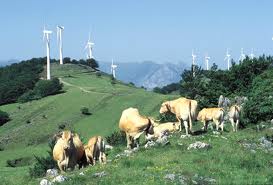There is now one country in the world where wind energy is the primary electricity source - you'd expect it to be Denmark, but it's Spain.
Before we get to Spain, let's look at Denmark, which also has big news to report: throughout December, wind supplied 54.8% of the country's electricity and 68.5% during Christmas week, reports The Copenhagen Post. Sure, demand is down during that week when people are off from work, but it's still impressive that on December 21, wind turbines produced enough electricity to exceed demand - 102%. 
In 2013, wind parks produced 11.1 billion kilowatt hours of energy from 4.792 gigawatts of capacity - meeting 33.2% of all electriciity consumed in Denmark.
As a comparison, China installed 16.1 GW of wind capacity in 2013 alone!
Wind Leads in Spain
For the first time in history, wind power is the leading source of a country's electricity!  

Nuclear was close behind at 20.8%, but wind supplied¬†20.9% of Spain's electricity in 2013,¬†according to¬†system operator Red El√©ctrica de Espa√Īa. Solar PV supplied 3.1%, combined cycle plants, 9.6%, and hydro, 14.4%.
Wind power rose 13.2% last year, producing a record 54,478 gigawatt hours (GWh) of electricity, enough to supply 15.5 million households, or 90% of the total, according to the Spanish Wind Energy Association (AEE). Nuclear actually produced 2,337 GWh more than wind last year, but because it consumes more electricity than wind to run its facilities, its contribution to the grid  was lower, they explain.
AEE points out how wind energy brought down electric prices. "The influence of wind on wholesale market prices is very clear if we consider the market on the more and less windy days. In 2013, the day in which the maximum coverage of daily demand with wind was reached, February 2, the market dropped to a 7.69 euros/MWh low. The minimum coverage took place on December 8, a day in which the market price climbed up to 93.11 euros/MWh."
When the wind barely blew in early December, electricity prices  reached a 112 euros/MWh high. During high wind days of Christmas Eve and Christmas Day, the market price dropped to 9.18 and 5.42 euros/MWh, respectively.
Celebration in the wind industry is muted however because the government has created so much uncertainty about energy reform. The feed-in laws that have propelled renewable energy - wind and solar - forward in the country have been racheted down and could even be cut or eliminated retroactively.
"If facilities already in place can't make the income they expected when investments were made, and don't know what to expect in the future, it will be difficult to encourage investors to invest in wind power in this country," says AEE.
Since 1997, when the first laws went into effect supporting wind development, fossil fuel imports to generate electricity and concommitant emissions are down over 20%, says AEE.
Because of the deep recession, Spain also ended its feed-in tariff for solar. In 2008, the country was the world's biggest solar market.
It looks like Germany could be following in its footsteps as the government accelerates similar cuts for solar and onshore wind. Politicians have been jostling over cuts to the iconic feed-in tariff for a couple of years now. They need renewable energy more than ever right now because of their commitment to close all nuclear plants, but they can't rectify the high prices associated with its feed-in law.
Chancellor Angela Merkel says her first priority is to reduce the cost of shuttering nuclear plants, transitioning to much more renewable energy. For now, solar and wind companies are reeling from the uncertainty and prospects of much lower income.



